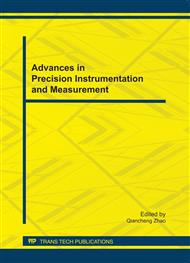[1]
Bai Y C, Zuo H, Cui Y L. The WDD Type Pseudo-Random Multi-function Transmitter for the Electrical Method. Geophysical & Geochemical Exploration, 2004, 28(6): 536-539.
Google Scholar
[2]
Bai Y C, Yang X S, Xiao J P, et al. Application of 1-wire technology in multi-electrodes data acquisition system of geoelectric field. J. Cent. Soth Univ. (Science and Technology), 2004, 35(3): 458-462.
Google Scholar
[3]
Zuo G Q, Luo W B, Li F, et al. The Synchronization of the Transmitter and Receiver Design Based on GPS. Geophysical & Geochemical Exploration, 2006, 30(2): 159-161.
Google Scholar
[4]
Luo W B, Bai Y C, Cui Y L. Application of In-system Programmable Technology on Electrical Exploration Transmitter Design. J. Cent. South Univ. (Science and Technology) . 2005, 36(1): 119-122.
Google Scholar
[5]
Zhang Y S, He J S, Zhuang H. Triple-frequency Electromagnetic Frequency Soundings. Journal of Central South University of Technology (Natural Science), 1995, 26(4): 430-434.
Google Scholar
[6]
Zhang Y S, He J S. Pseudo-random Triple-frequency Induced Polarization Method. Journal of Central South University of Technology (Natural Science), 1995, 26(2): 157-161.
Google Scholar
[7]
Chen R J, He J S, Bai Y C, et al. The Study of Relative Phase Spectrum in Multi-frequency Induced Polarization. Journal of Central South University (Science and Technology), 2004, 35(1): 106-111.
Google Scholar
[8]
He J S. 2nSeries Pseudo-random Signal and Its Application [A]. Chinese Geophysical Society. Annual of Chinese Geophysical Society (1998). Xi'an: Xi'an Map Press, (1998).
Google Scholar
[9]
Jiang T, Lin J, Yang D, et al. Analysis of directional seismic signal based on phased-array vibrator system. Chinese J. Geophys. (in Chinese), 2008, 51(5): 1551-1556.
Google Scholar
[10]
Yang J Z, Wei B J, Lin N. Basic theory of electromagnetic wave resistivity measurement while drilling tool with tilted antennas and its application for geo-steering. Journal of China University of Petroleum (Edition of Natural Science) (in Chinese), 2009, 33(1): 44-49.
Google Scholar
[11]
Cheng H, Li D Q, Di Q Y. et al. Foundation evaluation based on CSAMT method. Journal of Central south University (Science and Technology), 2010, V41 (4): 1561-1573.
Google Scholar
[12]
Cheng H, Di Q Y, Li D Q. The discussion electrical properties of rocks base on frequency characteristics. Progress in Geophy. (In Chinese), 2010, 25(3): 918-925.
Google Scholar
[13]
Cheng H, Cao F X, Di Q Y. Research and application of groundwater geophysical exploration in desert and gobi regions of northwestern China. Progress in Geophys. (In Chinese), 2009, 24(5): 1898-(1904).
Google Scholar


